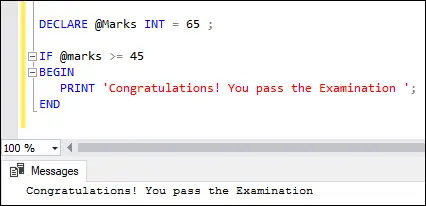IF-setningen er en del av kontrollflytfunksjonen i SQL Server. Vanligvis er det en beslutningstaking på ulike programmeringsspråk som returnerer en verdi basert på de gitte betingelsene . Denne setningen utfører koden skrevet i IF-blokken når den gitte betingelsen evalueres til sann, og når betingelsen evalueres som usann, vil ELSE-setningen bli utført.
IF-erklæringen
Følgende er syntaksen som illustrerer bruken av denne setningen i SQL Server:
IF boolean_expression BEGIN { statement_block } END I syntaksen ovenfor er statement_block i BEGYNNE...SLUTTE blokken utføres når boolsk_uttrykk er fornøyd med tilstanden. Ellers hoppes denne blokken over, og programkontrollen flyttes til setningen etter SLUTT søkeord. Vi bør vite at hvis uttrykket inneholder a PLUKKE UT uttalelse, må vi sett dem i parentes .
binært søketre]
Eksempel
La oss se eksemplet for å forstå IF-setningen uten ELSE-blokk. Eksempelet nedenfor vil vise resultatet når betingelsen er oppfylt. Ellers flyttet programkontrollen til setningen etter nøkkelordet END, hvis noen.
DECLARE @Marks INT = 65 ; IF @marks >= 45 BEGIN PRINT 'Congratulations! You pass the Examination'; END
Utførelse av setningen vil gi følgende utgang:

Nå vil vi demonstrere det på nedenfor Student' tabell med følgende data:

Nedenfor er et annet eksempel som får totalt antall karakterer av en valgt student fra ' Student' tabellen i eksempeldatabasen og skriver deretter ut en beskjed hvis det er mer enn 400 .
BEGIN DECLARE @Total_Marks INT; SELECT @Total_Marks = total_marks FROM Student WHERE age>25; SELECT @Total_Marks; IF @Total_Marks > 400 BEGIN PRINT 'Congratulations! You pass the Examination'; END END
Vi vil få utgangen nedenfor:

Hvis vi vil se utgangsmeldingen ovenfor, bør vi klikke på Meldinger fane:

IF-ELSE-erklæringen
I scenariet i den virkelige verden må vi utføre en handling når betingelsen i IF-setningen er TRUE eller FALSE. I dette tilfellet er IF…ELSE-setningen nyttig. Denne setningen utfører ELSE-setningsblokken når betingelsen i IF-leddet er evaluert FALSE.
Følgende er syntaksen som illustrerer bruken av IF ELSE-setningen i SQL Server :
IF expression BEGIN Statement block -- It executes when the IF clause expression is TRUE. END ELSE BEGIN Statement block -- It executes when the IF clause expression is FALSE. END
Eksempel
La oss se eksemplet for å forstå IF-setningen med ELSE-blokken. Eksempelet nedenfor vil vise meldingen ' Gratulerer! Du består eksamen ' når IF-betingelsen er oppfylt. Vis ellers ' Du er mislykket! Bedre lykke neste gang '.
DECLARE @Marks INT; SET @Marks = 65; IF @marks <45 begin print 'congratulations! you pass the examination'; end else 'you are failed! better luck next time'; < pre> <p>Executing the statement will give the below output. Here, the <strong>marks</strong> variable is <strong>65</strong> , and the <strong>condition (65<45)< strong> is not satisfied. Therefore, the message inside the ELSE block is displayed:</45)<></strong></p> <img src="//techcodeview.com/img/sql-server-tutorials/49/sql-server-if-else-5.webp" alt="SQL Server IF ELSE"> <p>We will get this output because the condition <strong>(65>45)</strong> is satisfied. Therefore, the message inside the IF block is displayed:</p> <img src="//techcodeview.com/img/sql-server-tutorials/49/sql-server-if-else-6.webp" alt="SQL Server IF ELSE"> <p>Now, we will demonstrate the IF ELSE statement on the above ' <strong>Student'</strong> table. In this example, we are going to check whether the student <strong>total marks</strong> is <strong>greater than or equal to 400</strong> or not as follows:</p> <ul> <li>When the IF condition is TRUE, we will get the student records whose total marks are greater than or equal to 550.</li> <li>If the condition is FALSE, we will get the student records whose total marks are less than 550.</li> </ul> <p>Here is the program:</p> <pre> DECLARE @Marks INT; SET @Marks = 600 ; IF @Marks >= 550 BEGIN SELECT id, name, gender, age, total_marks FROM Student WHERE total_marks >= 550 ORDER BY age ASC END ELSE BEGIN SELECT id, name, gender, age, total_marks FROM Student WHERE total_marks <550 order by age asc end < pre> <p>In this code, we have specified the <strong>@Marks</strong> variable to <strong>600</strong> , and the condition (600 >= 550) is satisfied. Therefore, we will get the output where student records whose total marks are greater than or equal to 550 are displayed.</p> <img src="//techcodeview.com/img/sql-server-tutorials/49/sql-server-if-else-7.webp" alt="SQL Server IF ELSE"> <p>If we changed the <strong>@Marks</strong> variable to <strong>500</strong> and the condition (500 >= 550) becomes false. Therefore, we will get the output where student records whose total marks are less than 550 are displayed.</p> <img src="//techcodeview.com/img/sql-server-tutorials/49/sql-server-if-else-8.webp" alt="SQL Server IF ELSE"> <h2>Nested IF ELSE Statement</h2> <p>Unlike other programming languages, we can nest an IF...ELSE statement inside another IF...ELSE statement in SQL Server. Let us demonstrate it with the following example:</p> <pre> DECLARE @age INT; SET @age = 6; IF @age <18 50 print 'you are underage'; else begin if @age < below 50'; senior cetizen'; end; pre> <p>In this example, we are going to check whether the <strong>age is underage, below 50, or senior citizen</strong> as follows:</p> <ul> <li>If the value of the <strong>@age</strong> variable is below <strong>18</strong> , it will print the person is <strong>underage</strong> .</li> <li>If the condition is FALSE, the ELSE part will be executed that has a nested IF…ELSE.</li> <li>If the value of the <strong>@age</strong> variable is under <strong>50</strong> , it will print <strong>below 50</strong> . Finally, if no condition is satisfied, it will print <strong>senior citizens</strong> .</li> </ul> <p>Here is the result:</p> <img src="//techcodeview.com/img/sql-server-tutorials/49/sql-server-if-else-9.webp" alt="SQL Server IF ELSE"> <p>This article gives a complete overview of how to use the SQL Server IF ELSE statement. Here we have learned:</p> <ul> <li>Variables are objects that serve as placeholders.</li> <li>The keyword BEGIN will be used to start a statement block, and the END keyword must be used to close it.</li> <li>The use of ELSE in an IF... ELSE statement is optional.</li> <li>It's also possible to nest an IF...ELSE statement inside another IF...ELSE statement. However, nesting an IF statement within another statement is bad practice because it makes the code difficult to read and maintain.</li> </ul> <hr></18></pre></550></pre></45>
